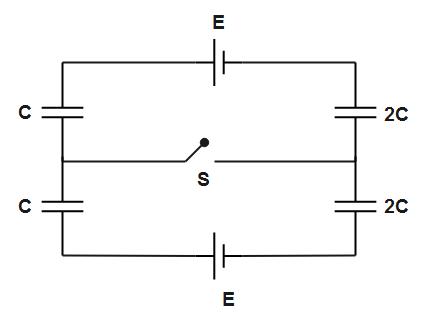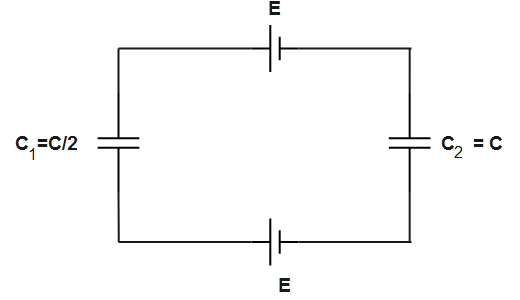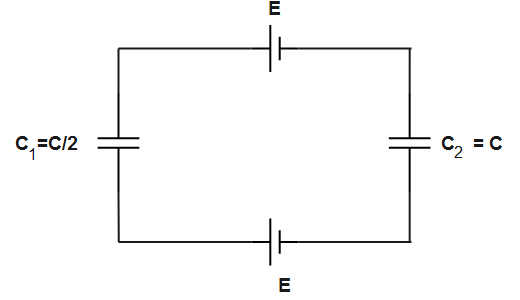
The energy stored in capacitors is U when S is open. Now S is closed, the charge passed through S is Q, then
(A). $U=0,\,Q=2CE$
(B). $U=C{{E}^{2}},\,Q=0$
(C). $U=0,\,Q=\dfrac{7}{6}CE$
(D). $U=0,\,Q=\dfrac{2}{3}CE$


Answer
513k+ views
Hint: The following figure contains capacitors connected in series combination along with two batteries connected in parallel combination. We resolve the circuit by calculating both equivalent capacitance as well as equivalent voltage in the circuit and calculate the charge in the circuit. The energy depends on the capacitance and the square of the potential drop.
Formulas Used:
$\dfrac{1}{C}=\dfrac{1}{{{C}_{1}}}+\dfrac{1}{{{C}_{2}}}$
$Q'=C''V$
Complete step by step answer:

Since all the capacitors are in series combination, the charge will be equal. On resolving the circuit by replacing the combination with an equivalent capacitor we get,
$\begin{align}
& \dfrac{1}{C}=\dfrac{1}{{{C}_{1}}}+\dfrac{1}{{{C}_{2}}} \\
& \Rightarrow \dfrac{1}{{{C}_{1}}}=\dfrac{1}{C}+\dfrac{1}{C} \\
& \Rightarrow \dfrac{1}{{{C}_{1}}}=\dfrac{2}{C} \\
& \therefore {{C}_{1}}=\dfrac{C}{2} \\
\end{align}$
Similarly,
$\begin{align}
& \dfrac{1}{{{C}_{2}}}=\dfrac{1}{2C}+\dfrac{1}{2C} \\
& \therefore {{C}_{2}}=C \\
\end{align}$

The equivalent capacitance in the above circuit is-
$\begin{align}
& \dfrac{1}{C'}=\dfrac{1}{C}+\dfrac{2}{C} \\
& \Rightarrow \dfrac{1}{C'}=\dfrac{3}{C} \\
& \Rightarrow C'=\dfrac{C}{3} \\
\end{align}$
The equivalent capacitance of the whole circuit is $\dfrac{C}{3}$.
The batteries are connected in series, hence the equivalent emf in the circuit will be $E+E=2E$.
We know that,
$Q'=C''V$ - (1)
Here, $Q'$ is the charge flowing in a circuit
$C''$ is the capacitance
$V$ is the potential difference
In the above equation, we substitute given values to get the charge on capacitor with capacitance $C$,
$\begin{align}
& Q'=\dfrac{C}{3}\times 2E \\
& \Rightarrow Q'=\dfrac{2CE}{3} \\
\end{align}$
All capacitors are connected in series therefore, the charge flowing through them is same. Therefore, the charge flowing through each capacitor is $\dfrac{2CE}{3}$.
The charge that flows through the wire when switch S is closed is $\dfrac{2CE}{3}$.

In the above figure, the plates of the capacitor are at the same potential that means there is no potential difference between the plates of the capacitor. Hence, there is no energy stored in the capacitors.
Therefore, the correct answer is option D.
Note: The combination of capacitors is analogous to the combination of resistors. Batteries can also be connected in series and parallel combination and their equivalent voltage depends on the emf as well as the internal resistance. The emf is the potential of the battery, it is always greater than the potential difference.
Formulas Used:
$\dfrac{1}{C}=\dfrac{1}{{{C}_{1}}}+\dfrac{1}{{{C}_{2}}}$
$Q'=C''V$
Complete step by step answer:

Since all the capacitors are in series combination, the charge will be equal. On resolving the circuit by replacing the combination with an equivalent capacitor we get,
$\begin{align}
& \dfrac{1}{C}=\dfrac{1}{{{C}_{1}}}+\dfrac{1}{{{C}_{2}}} \\
& \Rightarrow \dfrac{1}{{{C}_{1}}}=\dfrac{1}{C}+\dfrac{1}{C} \\
& \Rightarrow \dfrac{1}{{{C}_{1}}}=\dfrac{2}{C} \\
& \therefore {{C}_{1}}=\dfrac{C}{2} \\
\end{align}$
Similarly,
$\begin{align}
& \dfrac{1}{{{C}_{2}}}=\dfrac{1}{2C}+\dfrac{1}{2C} \\
& \therefore {{C}_{2}}=C \\
\end{align}$

The equivalent capacitance in the above circuit is-
$\begin{align}
& \dfrac{1}{C'}=\dfrac{1}{C}+\dfrac{2}{C} \\
& \Rightarrow \dfrac{1}{C'}=\dfrac{3}{C} \\
& \Rightarrow C'=\dfrac{C}{3} \\
\end{align}$
The equivalent capacitance of the whole circuit is $\dfrac{C}{3}$.
The batteries are connected in series, hence the equivalent emf in the circuit will be $E+E=2E$.
We know that,
$Q'=C''V$ - (1)
Here, $Q'$ is the charge flowing in a circuit
$C''$ is the capacitance
$V$ is the potential difference
In the above equation, we substitute given values to get the charge on capacitor with capacitance $C$,
$\begin{align}
& Q'=\dfrac{C}{3}\times 2E \\
& \Rightarrow Q'=\dfrac{2CE}{3} \\
\end{align}$
All capacitors are connected in series therefore, the charge flowing through them is same. Therefore, the charge flowing through each capacitor is $\dfrac{2CE}{3}$.
The charge that flows through the wire when switch S is closed is $\dfrac{2CE}{3}$.

In the above figure, the plates of the capacitor are at the same potential that means there is no potential difference between the plates of the capacitor. Hence, there is no energy stored in the capacitors.
Therefore, the correct answer is option D.
Note: The combination of capacitors is analogous to the combination of resistors. Batteries can also be connected in series and parallel combination and their equivalent voltage depends on the emf as well as the internal resistance. The emf is the potential of the battery, it is always greater than the potential difference.
Recently Updated Pages
A man running at a speed 5 ms is viewed in the side class 12 physics CBSE

The number of solutions in x in 02pi for which sqrt class 12 maths CBSE

State and explain Hardy Weinbergs Principle class 12 biology CBSE

Write any two methods of preparation of phenol Give class 12 chemistry CBSE

Which of the following statements is wrong a Amnion class 12 biology CBSE

Differentiate between action potential and resting class 12 biology CBSE

Trending doubts
What are the major means of transport Explain each class 12 social science CBSE

Which are the Top 10 Largest Countries of the World?

Draw a labelled sketch of the human eye class 12 physics CBSE

Explain sex determination in humans with line diag class 12 biology CBSE

Explain sex determination in humans with the help of class 12 biology CBSE

Differentiate between homogeneous and heterogeneous class 12 chemistry CBSE




